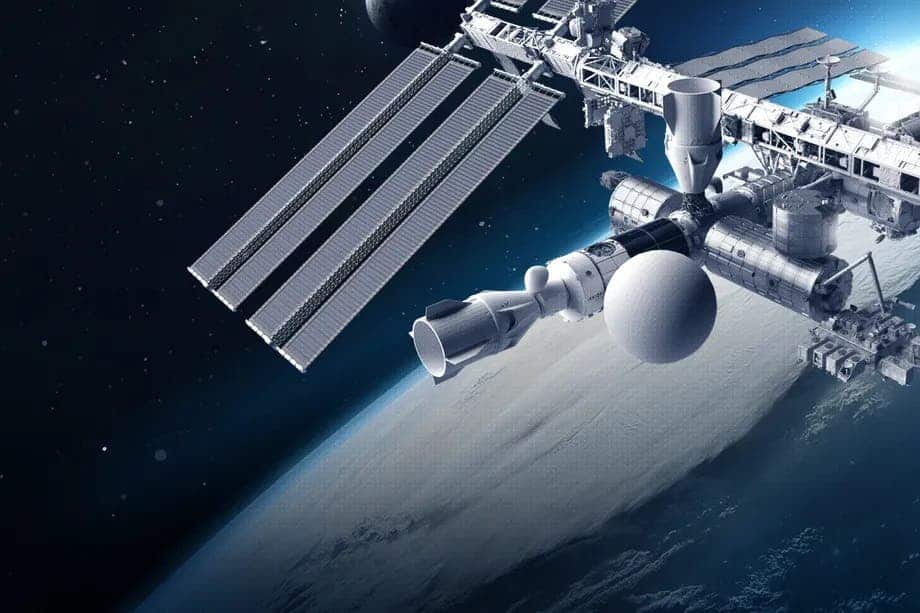
In the 24 years since it’s been in operation, the International Space Station (ISS) has welcomed over 244 astronauts, which have made 403 individual flights. With the exception of a few tourists, these were all astronauts on publicly-funded missions from NASA and its partners, such as Russia, Japan, Canada, or the European Space Agency. But in only two months, the first-ever private mission to the ISS is scheduled to commence.
The mission, called Axiom-1, is operated by the private space company Axiom Space, a Houston-based company founded in 2016 that aims to build and operate its own space station in low Earth orbit (LEO) in the coming years. In the meantime, Axiom Space wants to launch three missions to the ISS, for which it has signed a deal with SpaceX to send its own astronauts to space aboard the Dragon 2 capsule. SpaceX’s spacecraft has already flown three crewed missions to the ISS, all carrying NASA government astronauts and cargo. This time, however, will mark the first time a private space crew sets foot on the station.
Axiom-1 is set to launch on March 31, after a series of delays pushed back the initial launch originally planned for late 2021. Originally, movie star Tom Cruise and acclaimed director and producer Doug Liman were interested in joining the mission to film in space. However, the final lineup of Axiom-1 now includes Michael López-Alegría as the Spacecraft commander and Larry Connor as the Pilot, as well as Mark Pathy and Eytan Stibbe as Mission Specialists.
López-Alegría is an experienced astronaut who completed four previous spaceflights and a former NASA pilot. He is also the vice president of Axiom Space. Connor, Pathy, and Stibbe are all investors in the company and philanthropists.
Although Axiom-1 is expected to last no more than 10 days, the team has set out to complete an ambitious number of scientific experiments meant to improve our understanding of space and its impact on the human body. These include experiments on senescent cells, cells that stop multiplying but don’t die off when they should, which have been linked to age-related disorders; research into holoportation, a mixed reality technology that allows high-quality 3D models of people to be reconstructed, compressed, and transmitted anywhere; research on Spaceflight-Associated Neuro-Ocular Syndrome, which negatively affects visual sharpness in many astronauts; observations of Earth; and online education activities with students back on Earth.
“The goal for the Ax-1 crew is to set a standard for all future private astronaut missions in terms of our preparation and professionalism,” López-Alegría said. “As the commander, I am proud of the work these crew members have put in to be ready to conduct meaningful work on the International Space Station and glad to see them meet the standards required of all astronauts flying to station since Expedition 1. Ax-1 is focused on a huge amount of science and outreach activities, and we look forward now to finalizing that flight program.”
López-Alegría and the rest of the crew have been training at NASA’s Johnson Space Center in Houston, as well as other NASA facilities, since August 2021. During this time, they were trained on how to use station systems, scientific facilities, and emergency procedures.
NASA is welcoming this partnership with open arms. It’s in the space agency’s best interest to support a growing low-orbit economy. As more trusted partners come aboard, commercial spaceflight will become less and less expensive, benefiting all stakeholders. NASA can then focus on more ambitious missions like Artemis — a manned mission to the Moon in preparation for crewed trips to Mars.
Although there’s no official date yet, Axiom Space already announced the crew for Axiom-2, commanded by Peggy Whitson, a veteran astronaut with three trips to the ISS under her belt and the record-holder for the longest-serving American in space. Whitson will be joined by pilot John Shoffner, an American racing driver and investor. Axiom-2 will research single-cell genomics, the study of the individuality of cells using omics approaches.
“To experience astronaut training teamed with Peggy is an honour. I am also excited about our upcoming work with 10x Genomics in this first step towards making their single-cell technologies available to researchers in a microgravity environment.” said Shoffner.
“I look forward to the process of testing and validating this technology for future groundbreaking work in low-Earth orbit.”
Tom Cruise’s plans for space haven’t been scrapped either. In fact, they’ve only become grander. Axiom has signed a deal with Space Entertainment Enterprise, co-founded by producers Elena and Dmitry Lesnevsky, to build and attach a module to the ISS, which would be “the world’s first content and entertainment studios and multipurpose arena in space.” Called SEE-1, the module is scheduled to launch in December 2024, where Tom Cruise is expected to film a future space movie in actual microgravity.

Axiom previously won a $140 million NASA contract to attach a habitable module to the ISS. This module will, at some point, detach before the ISS retires in 2030, to lay the foundation for the free-flying Axiom Station, pictured below.



